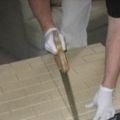What Kind of Chimney Liner Installation do Inserts Need?
Don't just stick your head up the flue with a flashlight, you won't be able to see a thing. Do call a professional chimney sweep service. You have to have the chimney swept in order to really see what condition it is in. Hopefully, this has been part of your annual maintenance so it won't be an ordeal. If you are buying a home that is new to you, having the chimney swept as soon as you take ownership will allow for a full inspection of the liner. Liners are rarely repaired in the sense of patch repair, they are generally replaced completely with a full chimney liner installation because they must have whole integrity to work correctly.
What does the chimney liner do?
Chimney liners are what allow a chimney to function safely. While the brick used to construct a fireplace is fire proof, stone is not. Stone can explode if a liner is not used. Even fireproof brick needs a liner but for another reason (that applies to stone as well). The nature of the liner is it prevents heat and gas transfer. As your fire burns you need to feed it with oxygen and disburse the carbon dioxide and heat that you aren't using. The chimney liner lets all of that escape outside of your home. Without a liner, or without a liner in good condition, all of that heat and gas can pass through the walls of your home and create dangerous situations.
Chimney liner installation types
There are several different types of liners that can be installed. For a regular operating chimney you are looking at the tradition clay or terracotta tile, there are also cast in place linings and metal linings too. For chimneys that are being used with inserts you have those same choices, but then the insert itself has to connect to a feeder to the cap. Depending on the insert type it may need an actual pipe to the top of the cap, or just one to run it past the flue and into the chimney. You don't always have to reline the whole chimney when you are using an insert with a full pipe style installation, but that pipe has to be adequately insulated within the chimney to control heat loss if your lining won't be able to do it.
Using inserts with no fireplace
Some people do use inserts that are not connected to a fireplace. For this type of installation you definitely need to consult with a professional chimney service. Their expertise isn't just about chimneys and flues, it's about containing heat transfer through buildings. They can help you to design a pass through that minimizes heat loss and fire risk too. They can also make sure that the base and surrounding wall liners are put in correctly as most free standing inserts cause fires below their base due to homeowners not installing them on liners correctly.
Talk to a professional to make sure the right installation is done
Having the right chimney liner installation done is essential to the efficiency and safety of your insert when it is running. Your best practice is to not make a decision based upon the manufacturer's suggestion but to talk to a professional chimney service about what type of liner you should have. The manual that comes with the insert only covers generic installations. A professional service can evaluate all the different factors that affect your liner choice and your inset performance. Everything from the age of your home to the ceiling height and the overlay of tree cover on your home has an effect. That is something your manual can't take into account so talk to a professional to find out what type of chimney liner installation you should have. They can help you choose the right one for a regular operating chimney, or one being used with an insert.



